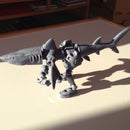Introduction: How to Set Up Your Makerbot Replicator 2
You've just gotten your nice new Makerbot Replicator 2 3D printer, and of course you're excited to get started doing amazing things with it. This guide will take you through getting it set up, with some additional tips and tricks you won't find in the instruction manual.
A lot of the material in this guide builds upon and expands on the official Makerbot documentation for the Replicator 2, found here. Refer to that as well if you get stuck.
Step 1: Unboxing
TOP TIP: The thick black cable that goes from the back of the printer to the machinery in the middle is NOT a handle - never pull on it! (It is the wrapping around a bunch of electrical cables that power the extruder mechanism, and its heaters and temperature sensors.)
Here's what you'll do:
- Open the box. Be careful if you use a blade, so that you don't cut through the manual.
- The first thing you'll find is a foam tray, with the manual nested in it. Take it out and set it aside.
- Take out the foam tray.
- Take out the two foam inserts.
- Open the clear plastic bag that covers the Makerbot, and fold it out of the way.
- Reach in and hold the Makerbot by its sides (NOT the thick black cable) and lift it out.
- Place the Makerbot somewhere safe.
- Take out any other packaging material.
- Lift out the accessory box from the bottom of the box.
Step 2: Location and Setup
You want to have some room all the way around it, so you can get to the power switch, and have room to change the filament spool. Also, consider that the Makerbot has parts that will get very, very hot, so consider placing it somewhere that little hands won't reach and also make sure that there is no way that flammable materials could contact the hot parts. For example, don't put it near curtains or drapes that could be blown over it.
For best print quality, you want to avoid placing it anywhere where it will be exposed to drafts or air currents, since this may cause cracking or warping.
Finally bear in mind that while it is operating it might be quite noisy, and will produce some gases and vapors. The PLA plastic used by the Replicator 2 is generally non-toxic, but you may want to avoid prolonged exposure to it.
Now that you've got it placed, let's get it set up:
- Remove the packing blocks in to uppermost corners - you'll need to cut quite a thick zip tie, so use a good knife or scissors.
- Remove the plastic restraint next to the extruder carriage.
- Find the clear plastic tube (in the accessory box) and thread it into the hole on top of the extruder
- Clip the other end of the plastic tube into the bracket in the back
- Mount the spool holder by tiliting it up, putting the square part through the hole, and then let it down
- Finally, make sure the power switch on the Makerbot is off, and plug in the power supply
Step 3: Blue Tape!
The thick clear acrylic plate is where your prints will be made. It is important that your prints stick to the surface well for best results. If the plate is very very clean, you can just print directly on to the plastic. However, most people get better results with a rougher surface, and one way to achieve it is by laying down a layer of blue painter's tape.
The Makerbot includes 3 sheets of blue tape, sized to fit the build platform. Stick it carefully on to the acrylic build plate from one side to the other, trying to avoid creating wrinkles or ripples.
You will almost certainly use more more than 3 sheets pretty quickly, so you'll eventually be using regular (narrower) painter's tape. You can lay it down in parallel strips, but make sure that it does not overlap. An overlap creates a bump that that can snag the extruder nozzle.
Step 4: Calibrate, Level Build Platform and Load Filament
Before you print, you have to make sure everything is properly lined up. The most important step is to make sure the build platform (the thick acrylic plate) is absolutely level.
First, make sure that the extruder head can move freely in all directions. There should not be any binding or obstruction, it should slide freely. The only friction you feel should be the motors freewheeling.
Next, install the build platform. You'll notice that it has two small notches that go towards the front, and a single large notch that goes towards the back. Insert the plate, pressing it against the spring loaded tab at the back (gently) and then press it down so that it is locked in place by the two plastic tabs at the front.
Now it's time to load some filament and level the build platform. Plug the power supply into the back of the Makerbot, and turn it on. It will start to guide you through the rest of the setup process, with instructions on the little screen in front.
You will first level the build platform. (Note that in the video the build platform is NOT covered in blue tape, but our experience suggests that you will want to do this, and you should do it BEFORE you level the build platform).
You will first tighten the screws on the bottom of the platform, lowering the bed AWAY from the nozzles. The startup routine will then move the nozzle to each corner - at each stop, loosen the screws until a thin card just barely slides between the nozzle and the platform. Once you're done, it will move the extruder nozzle to 3 additional points so you can verify the leveling. Note that you are leveling with regard to the extruder nozzle, not to the floor!
After that, time to load the filament. The instructions on the screen will guide you through preheating the extruder. You should then remove the clear plastic tube from the top of the extruder, and then go to the other end of the tube and start feeding the filament through it. Note that there should not be any sharp bends in the filament as it goes into the tube. If your filament spool is on the right (facing the back of the printer) then it should rotate clockwise.
Take the filament that is coming out of the other end (the extruder end) and feed it into the top of the extruder block. The Makerbot will tell you on its screen when the extruder is sufficiently warm, and ask you to load the filament. Press the filament in, you should feel the motor "grab" it and pull quite strongly.
When it's extruded a bit, press the M button to stop, and go to the next step.
Step 5: First Print
The Makerbot tutorial videos are great, check this one out for the startup process and first print:
Step 6: Organizing Your Workspace - Tools
These are the tools that came with the printer:
- A set of hex wrenches: These are metric sized (like almost all the fasteners on the Makerbot), and you'll need them when (not if!) you need to take apart the extruder to clean it or remove clogs.
- Small pouch of lubricant: This is a PTFE (basically Teflon) based grease that is used to lubricate the main moving parts every 50 hours.
- Blue tape: Apply this to the build platform to help your prints stick better - depending on your settings, this may need to be replaced quite often.
- USB cable: Used to connect the printer to a computer. It is actually a better idea to print from the SD card in the printer, not connected via USB, so you won't need this too often.
- A small chisel or scraper to help you remove prints from the print bed
- An X-acto knife or similar to remove support material from prints (keep away from children!)
- Nippers or cutters to cleanly cut filament
- Extra supplies of blue painter's tape
- Krazy glue or other cyanoacrylate glue, for repairs or for putting together multi-part prints (keep away from children!)
- Hot air gun - useful for removing the plastic "bruising" that occurs when you break off support material
- More lubricant - I like Tri-Flo PTFE based lubricant myself
Step 7: Organizing Your Workspace - Materials
The key things you want to ensure:
- No tangles! When you remove a spool from the printer, make sure to take the free end and pass it through the small holes on the rim of the spool. This will keep it from forming a tangle.
- Avoid exposure to heat, moisture and direct sunlight - all of these will negatively affect the reliability of printing
Step 8: Download Software
Now that you've set up your printer and everything is working, you'll want to download some software so that you can do more with it.
The most important piece of software you will need is Makerware, from Makerbot. This is a powerful utility that allows you to take 3D models that you've designed yourself or downloaded, and prepare them for printing. Get it here.
You should also explore options to allow you to create 3D models of your own. 123D Design is free, and available in a browser-based version, for download on Mac OS X and Windows, and for iOS mobile devices. By saving your files to the 123D website, you can later export an STL file suitable for 3D printing.
Tinkercad is another great option, it is simple and easy to use, and also exports STL files directly, which you can 3D print.
123D Catch lets you take photographs of real objects, and turns it into a 3D model that you can edit and print.
Finally, for more advanced use, Meshmixer is an extremely powerful program that lets you import many different typs of file, and remix them as if they were clay.
All of these options are easy to use and free of charge.
Step 9: Get 3D Models
If you're not ready yet to design your own 3D models, there are many places where you can download models for printing, or to use as a starting point for your own projects.
Thingiverse is a great place to start, it has a large collection of user contributed models that have been designed to work with a Makerbot.
123Dapp.com also has an extensive collection of 3D print ready models - many are based on scans of real world objects made with 123D Catch, fantastic creatures from 123D Creature, and an extensive library of professionally made models from the 123D Content Library.
Step 10: What's Next?
So you've gotten set up with your 3D printer, everything is working, you know how to download or create 3D models - so now what's next?
One thing you can do is connect with others who are in the same situation: join the Getting Started with 3D Printing group on Instructables.
You'll also want to stay up-to-date with what other users are doing: subscribe to the 3D Printing Channel on Instructables, and keep an eye on exciting new projects on 123dapp.com
Of course, we'd love to know what you're doing, so go ahead and write an Instructable, and create and share your projects on 123dapp.com!













